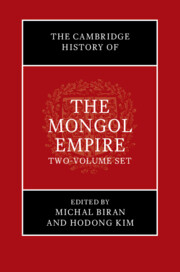Book contents
- The Cambridge History of the Mongol Empire
- The Cambridge History of the Mongol Empire
- Copyright page
- Dedication
- Contents
- Figures in Volume I
- Figures in Volume II
- Maps in Volume I
- Maps in Volume II
- Tables in Volume I
- Contributors to Volume I
- Contributors to Volume II
- Acknowledgments
- Notes on Dates and Transliterations
- Abbreviations
- Volume I
- Introduction
- Volume I Part 1 Political History
- Volume I Part 2 Thematic Histories
- Volume I Part 3 Views from the Edges
- Volume I Part 4 External Histories
- 20 The Mongols and Europe
- 21 The Mongols and the Arab Middle East
- 22 South Asia and the Mongol Empire
- Epilogue
- Volume II
- Index to Volume I
- Index to Volume II
- References
21 - The Mongols and the Arab Middle East
from Volume I Part 4 - External Histories
Published online by Cambridge University Press: 01 January 2024
- The Cambridge History of the Mongol Empire
- The Cambridge History of the Mongol Empire
- Copyright page
- Dedication
- Contents
- Figures in Volume I
- Figures in Volume II
- Maps in Volume I
- Maps in Volume II
- Tables in Volume I
- Contributors to Volume I
- Contributors to Volume II
- Acknowledgments
- Notes on Dates and Transliterations
- Abbreviations
- Volume I
- Introduction
- Volume I Part 1 Political History
- Volume I Part 2 Thematic Histories
- Volume I Part 3 Views from the Edges
- Volume I Part 4 External Histories
- 20 The Mongols and Europe
- 21 The Mongols and the Arab Middle East
- 22 South Asia and the Mongol Empire
- Epilogue
- Volume II
- Index to Volume I
- Index to Volume II
- References
Summary
In the first half of the thirteenth century, Mongol forces launched raids into areas that are now parts of Iraq and Syria. Raids turned into conquest with Hülegü’s movement into the region in the mid-1250s. Baghdad was taken in 1258, and by spring 1260, much of Syria was overrun by Mongol forces. A small Mongol army, however, was defeated by the Mamluks from Egypt in northern Palestine later that year. After a clear border was established along the Euphrates, for sixty years the Mamluks and Ilkhanids struggled for regional supremacy in major battles, frontier warfare, and diplomatic démarches. Around 1320, this conflict ended after negotiations, with peace agreements in place until the breakup of the Ilkhanate after 1335. Although ultimately unsuccessful in conquering lands beyond Iraq, the impact of the Mongols on greater Syria, Egypt, and Arabia was significant, not only militarily, but in the realm of demography, culture, and economy.
Keywords
- Type
- Chapter
- Information
- The Cambridge History of the Mongol Empire , pp. 798 - 826Publisher: Cambridge University PressPrint publication year: 2023

